![]()
![]()
![]()
Use LEFT and RIGHT arrow keys to navigate between flashcards;
Use UP and DOWN arrow keys to flip the card;
H to show hint;
A reads text to speech;
86 Cards in this Set
- Front
- Back
|
Genetic Anomalies
|
Down's Syndrome
Phenylketonuria (PKU) Sex Linked- Color Blindness |
|
|
differentiation
|
the gradual change from the general to the particular, from the simple to the complex
ie. cells |
|
|
Apgar scale
|
to check if the newborn is healthy
if it's blue then that means there's something wrong with the cardiovascular system |
|
|
Maturation
|
the unfolding of physical and behavioral patterns that are genetically programmed in the species which occur in the light of experience/environment
-physical growth requires nutrients -development of the visual system -language acquisition -development of motorskills |
|
|
Piaget's Key Concepts:
Schemas |
action patterns through which an infant organizes the world
ie: sucking and swallowing and so on two processes for his view that are responsible for all cognitive development |
|
|
What are the newborn's "equipment"?
|
Grasp reflex (up to 3-4 months, Rooting reflex (disappears at about 3 weeks), Sucking (permanent), Eye blink (permanent), Stepping (disappears at about 2 months), Sound orientation (permanent), Sensitivity to maternal odor
|
|
|
What are the Components of Post-Natal Physical Development?
|
Growth of the brain, Growth of the body, Integration of brain and body. Basically how the baby develops after it is born.
|
|
|
What are the Newborn's Equipment?
|
Rooting reflex-when you touch the side of their face, they turn their head to that side
grasp reflex, 3 months -sound sensitivity/orientation-prefer to hear mother's voice |
|
|
What effects do Rich environments have?
|
the richer the environment, the better neuron cortex developes
|
|
|
Explain the relationship between gene and environment?
|
-it's birelational
-it interacts with each other genetics determine the sensitivity towards the environment -environment plays a large role in determining how the genetic pattern is expressed. the genetic pattern in turn makes the organism sensitive to some factors int he environment, but less sensitive to others. |
|
|
PIaget's Theory of Development: Schema
|
how we organize information to interpret the world
|
|
|
Piaget's Theory of Develpment: Assimulation
|
use knowledge to apply to the world
existed schema-> world |
|
|
Piaget's Theory of Development: Accomodation
|
adapt to new world and build new schema
change existing schema |
|
|
What are Piaget's stages of cognitive development?
|
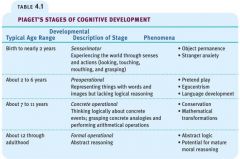
Sensorimotor stage- (0-2)
Preoperational-(3-6) Concrete operational-(7-12) Formal operational-(12--> |
|
|
Sensorimotor Stage
|
0-2
-do not have object permanance -Means-ends behavior -Development of Deffered Imitation |
|
|
What is Means-Ends Behavior?
|
in the sensorimotor stage
-about 8 months -when they try to do simple problem solving -does anything they cna to acquire object/problem solving ex: say they want an object, they reach and reach till they get it |
|
|
What is A not B effect?
|
during the sensorimotor stage
-emerges at around 8 months -the experimenter takes a toy and hides it under a scarf. they keep repeating it for the baby to observe, and the baby always picks the toy under the same scarf. later when the experimenter hides the toy in the other scarf with the baby observing, the baby still picks the original one -this suggests a dissociation between what the infant kows and what he does |
|
|
What is Object Permanance?
|
for children in the sensorimotor stage, if they can't see the object, then the object doesn't exist.
-but for children in the preoperational stage and above, they know that even if you cover it or something, the object is still there |
|
|
What is deferred Imitation?
|
imitative behavior which is carried out in the absence of direct/overt stimulus
-like when you stick your tongue out, the baby does too |
|
|
What is going on in the cognitive thinking during hte Pre-Operational Stage?
|
-have object permanance
-cannot understand conservation of measures (mass and numbers) -ecocentrism-thinks everyone sees what they see -intuitive reasoning- uses excuses to come up with reasoning |
|
|
Egocentrism
|
children think that everyone sees from their point of view
-left and right front bavck confusions because they view the world relative to their own perspective -children confuse their own thoughts feelings and points of views with those of another |
|
|
Intuitive reasoining
|
when they make excuses to explain the world
|
|
|
Concrete Operational
|
ages 7-12
-master conservation -basic and mathematical reasoning -no abstract reasoning -master of seriation |
|
|
CHaracteristics of Formal Operation
|
age 12 and up
-isolation of variables -combinatorial reasoning -proportional reasoning -propositional logic |
|
|
Problems with Piaget's Stage Theory
|
-the stage are not discrete
-mastery of specific task does not imply mastery of all comparable tasks -piaget underestimated children's abilities -the one experiment to disapprove of object permanance: when there is a screen that falls down completely instead of falling on top of the block, the children are surprised -can't say that all 6 year olds are definately in preoperational stage, because they could be ahead |
|
|
What is an infant's sense of support like?
|
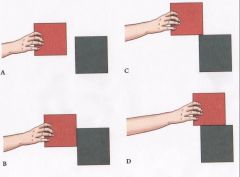
Examples of the blocks
at 3 month: they believe that any physical contact between objects will make it stable at 5 months: learns that a support has to be underneath the supported object at 6 months: infants learn that the support has to be appropriately positioned |
|
|
What is an infant's sense of occlusion like?
|
Occlusion are objects that are partially hiddne from view
-infants have a primitive concept of space, objects, number, and even the existence of other minds. -this kinda proves Piaget wrong because the infant's world is not so different from the adult's ex: the girl standing behind the fence--babies will already think of the girl as a whole girl not a girl with blank pieces through her the rod: babies were surprised that the rod occluded rod was two rods moving back and forth instead of one whole one the box and screen experiment: babies were surprised when the screnn moved all the way down instead of falling on top of the box |
|
|
How do infants respond to faces?
|
it is innate that they prefer faces
-they immitate facial expression as less days as 21 days -in one study of newborns just a few minutes old, the experimenter moved several patterns infront of the child's eyes. the infnats turned their heads and looked longer at the pattern when it was a schematic rather than a scrambled face |
|
|
Why is it important that babies immitate faces well?
|
-it reveals the baby's ability to intercoordinate sensory information and motor actions.
-this makes it clear that infants are ready to bein one kind of nonverbal communication |
|
|
What is revealed about babies and shared attention?
|
-babies tend to gazein the direction of their mother's gaze
-infants seem to understand the world they observe in terms of other's goals, and not just their actions. pg.485 |
|
|
What is the numerical skills in preschoolers like?
|
-they are able to count, but not really able to understand it
-they gradually grasp the principles of numerical reasoning such as "more than and less than" - |
|
|
What is theory of mind?
|
the set of interrelated concepts and beliefs that we all employ whenever we try to make sense of our own behavior or that of others
-the knowledge of different people having different beliefs and desires and it may be true or false or differe from our own |
|
|
Do children have theory of mind? Are they able to have any understand of the actions or thoughts of other individuals?
|
Theory of Mind is having your own concepts and beliefs so that you can make sense of other people and your own beliefs
-if tested in the right way, they do have some understanding -young children do understande both the relatinoship between desires and actions and the crucial fact that other poeple have desires different from their own. ex: when experimenters made a yuck face or a smiling face at the different foods they tasted, the children offered them the food they smiled at |
|
|
Explain the False-belief test and its significance
|
The child watches as the experimenter makes the teddy bear hide the ball in the oatmeal container. while the teddy bear is gone, the experimenter and child move the ball to the box. when the child is now asked, where does the teddy bear think the ball is, she points to the box.
-children seem to assume that their beliefs are inevitably shared by others, and likewise they seem not to appreciate that others might have beliefs that are false. -at about age 4, children will learn that not all knowledge is shared, that different individuals have different beliefs, and that which beliefs one will have depends on the appropriate access to the relevant information. |
|
|
What is the information- processing approach
|
the ability to pay attention, the capacity to remember, to reason, to make judgments
-compares human cognitive functioning to the complex ways that a computer functions |
|
|
Describe the memory in infancy
|
-infants can retain experiences overtime
|
|
|
Describe the memory in childhood
|
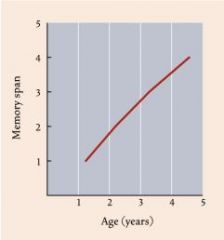
-memory is much increased but still limited in comparison to an adult's
|
|
|
What are the different types of memory?
|
-sensory register
-working memory -long term memory |
|
|
What are teh Simple cognitive correlates
|
-simple reaction times
-choice reaction times -lexical access -designed to provide a direct measure of how quickly words can be accessed in long term memory |
|
|
What is Metacognition
|
-awareness and understanding one's thinking and cognitive processes; thinking about thinking
-not limited to memory -adults have metacognitive understanding about langauage, so that htey can do more than talk and understand-they can also play with language as in puns or poems etc. -problem solving -children seem to lack an understadning of their own mental processes and with it an undersatnding of when a strategy would be useful |
|
|
What is fluid intelligence?
|
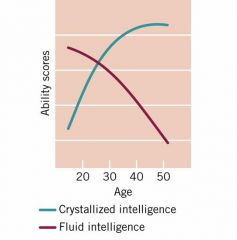
a person’s speed of processing in new situations
-speed of intellectual functioning, especially in arenas that are new to the person, and require some strategy choice and how to act upon it -starts to decline as the person is in their thirties |
|
|
What is crystallized intelligence?
|
-a person’s stored knowledge
-refers to a person's accumulated knowledge including vocabulary, facts they know, and the strategies they have learned -remains relatively stable across the life span, sometimes it grows due to more life experiences |
|
|
What is the most studied Social development?
|
Attatchment
|
|
|
What is Freud's theory of social attachment?
|
he believes that attachment arises from the infant’s need for food
-known as the cupboard theory |
|
|
What is Harlow's experiment for social attachment?
|
attatchment is based on a monkey that provided milk but was made of just wire, and another monkey that provided no food but was made of terry cloth that was soft
the baby monkey always preferred the cloth one, therefore proving that attatchment is with comfort and not for survival |
|
|
What's Bowlby's theory of attatchment?
|
-babies enjoy interacting with their mother and quickly learn to recognize and prefer their mother's voice and even her smell
-this behavior is not only motivated by contact but also a built-in fear of the unknown -states that what really matters is the sense of safety, comfort and refuge |
|
|
What are the different types of Attatchment?
|
-stable secure attatchment
-unstable secure attatchment -insecure attatchment -ambivalent attatchment |
|
|
Describe the Strange Situation experiment by Mary Ainsworth
|
-it is to assess the quality of attatchment with their mothers
-the mother and child enter a unfamiliar room. Then the experimenter walks in and talks to the mother, and approaches the child. then the mother leaves the child alone with the stranger. -after a few minutes a reunion follows, the mother returns and the stranger leaves |
|
|
What are the different qualities of attatchment as found in Ainsworth's experiment?
|
-secure attatchment
-insecure attatchment -ambivalent attatchment |
|
|
What is a Secure attatchment like from the Strange Situation experiment?
|
children explore room, play with the toys, and even make wary overtures to the stranger, as long as the mother is present
-after mother leaves, they show minor distress -when they return, they greet her with great enthusiasm |
|
|
What is a Insecure attatchment like from the Strange Situation experiment?
|
-they do not explore even in the mother's presence
-when mothers leave, they become upset and panicky -when mother comes back, children are crying and runing to her to be picked up, but then kickin gor slapping her and struggling to get down |
|
|
What is a Ambivalent attatchment like from teh Strange Situation experiment?
|
-they are distant and aloof while the mother is present
-they sometimes search for her in her absence -then they usually hit her when she returns |
|
|
What is Imprinting? Who did research on this?
|
-a kind of learning that occurs during hte critical period, and provides the basis for an infant's attatchment to its mother
-Lorenz was the person who researched it |
|
|
Why do an infant's early pattern of attatchment change?
|
-it is due to their environment circumstances
-the securely attatched infants were put under a period of family stress, such as serious illness int he family, marital conflict, or unemployment of a parent -the change of pattern was due to mothers with the most domestic stress |
|
|
How do secure infants affect their future behavior?
|
-children are more popular and outgoing and well adjusted in nursery school
-secure infants predicts a lower incidence of anxiety disorders in chilhood and adolesence |
|
|
What kind of attatchment do infants form with their fathers?
|
They have more active play than mothers
-children whose fathers are active particpants in their lives tend to do better in school, show better conduc, have fewer emotional problems, and are less likely to become pregnant or delinquent at adolesence |
|
|
What happens if the quality of day care is poor?
|
-the children are inattentive and unsociable in preschool compared to children who spent the same amount of time in good day-care centers
|
|
|
What happens to the children with disrupted attatchment like domestic conflict and divorce?
|
-children suffer from many emotional problems
-depression and withdrawn, more likely to drop out of highschool it's hard living in the stressful home environment that existed prior to the divorce |
|
|
What happens to children with no attatchment at all?
|
-for monkeys they huddled in corners and kept to themselves
-during courtship, they were abnormal. males were not amorous, and females resisted sexual overtures -females had no trace of love for their offspring for humans: - compared to normally reared children, the orphans showed a higher cortisol level, indicating they were chronically stressed -Kean said that all they needed was to be comforted, and even if they were comforted by mentally retarded patients, they showed a significant improvement in learning and stimulation and such -when children do not have attatchments from parents, they will be rightened by their peers and hampered in their further social development--the parental attatchment provides the basis for developing later relationships |
|
|
Are the effects of early social deprivation reversible?
|
their past may not be so reversible, but there are some recovery of early damamge
-with monkeys, to become socicialized again, they were reintroduced to younger monkeys - some children improve substantially while others remain severely socially and intellectually impaired |
|
|
What is socialization
|
The process through which someone learns to be a member of a social group.
- ways of acting - how we interpret the world around us - beliefs |
|
|
What are the theories of socialization?
|
Reinforcement
Social Learning Theory Cognitive Development Theory |
|
|
What is the Reinforcement theory of Socialization?
|
children are socialized by a calculus of pain and pleasure- instinctual urges are channeled by “do’s” and “don’ts
|
|
|
What is the Social Learning Theory of Socialization?
|
when children learn how to socialize by observation
-Children are more likely to imitate people they like and are attached to, respect, and consider competent. -Children also consider the consequences of their actions |
|
|
What is Cognative Development Theory of Socialization?
|
emphasizes the role of understanding in interpersonal thought and action
-they understand what they are doing is good and bad -can comprehend how they should relate to others and why they should act a certain way -this comprehension deepens as their mental development unfolds |
|
|
What are the different parenting styles?
|
authoritarian
permissive uninvolved authoritative |
|
|
What is the Authoritarian parenting style?
|
they have strict standards about how they think children should speak and act
-try to mold their children's behavior accordingly -the children tend to be lacking in independence, angry and defiant -make their children follow their strict rules and have severe punishments if not followed. no negotiations. |
|
|
What is the Permissive parenting style?
|
-no rules at all, and they are allowed to do whatever they want
-the parents are involved though -children tend to not be academically or socially curious |
|
|
What is the Uninvovled parenting style?
|
parents let their children do whatever they want and are not invovled in their children's life
-children are definately not acadmeically or socially curious |
|
|
What is the Authoritative parenting style?
|
-best way
-parents both exercise their power and accept the reciprocal obligation to respond to their children's opinons and reasonable demands -the children tend to be more self-confident, self-reliant, did better in highschool |
|
|
What are the child's effect on the parents?
|
-parents respond differently to infants with different temperants
-correlation between the parent's behavior and their childrens, not because the parents are shaping their children's behavior -parent's behavior is shaped by children |
|
|
What are Kohlberg's stages of moral reasoning?
|
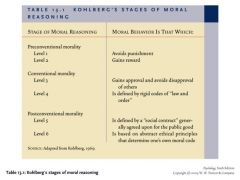
Preconventional Level
1. avoids punishment 2. gains reward Conventional Mortality 3.gains approval and avoids disapproval of others 4.is defined by rigid codes of "law and order" Post Conventional Mortality 5. is defined by a "social contract" generally agreed upon for the public good 6. Is based on abstract ethical principles that determine one's own moral code |
|
|
What is Freud's theory of internalization and self-punishment?
|
internalization is produced by self-punishment in the form of guilt and anxiety
-when children do something wrong, they are punished -as a result the forbidden act becomes associated with anxiety, so to avoid anxiety, they stop doing the act |
|
|
What is internalization and minimal sufficiency?
|
There is a theory that if you have parents who have very strong punishments if you do something wrong, the anxiety that is associated with this punishment will prevet the children from doing wrong.
-however, this is definately not the case. chidlren with autocratic parents are more likely to cheat for a prize when they thought no one was looking, and they were less likely to feel guilt about their misdeeds or to confess them when confronted. -on the contrast, prohibitions are most internalized by children whose parents took them aside to explain just how they had misbehaved and why they should behave differently |
|
|
What is the Principle of Minimal Sufficiency?
|
chidlren will internalize a certain way of acting if they feel just enough pressure to get them to behave in this new way, but not so much pressure that they feel foced to do so.
-if they feel too forced, then they will feel like it's resisted temptation |
|
|
What is empathy?
|
-a direct emotional response to another person's circumstances, even when we stand to gain nothing from such a reaction
-feeling for another, but not implying helping the other |
|
|
Are children able to feel empathetic?
|
Yes,
-new borns cry when they hear others crying -when his mother cuts her finger, instead of bringing a bandaid, he brings to her his comfrot toy |
|
|
What are erikson's eight ages of man?
|
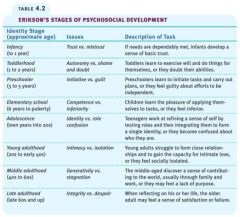
Infancy- trust vs. mistrust
-attatchment to mother, which lays foundation for later trust in others Toddlerhood-1.5-3 years -autonomy vs. shame and doubt -gaining some basic control fo self and environment (toilet training, exploration) Preschooler-3-6 years -intuitive vs. guilt -becoming purposeful and directive Elementary School-6-puberty -competence vs. inferiority -developing social, physical, and school skills Adolescence-puberty into 20's -identity vs. role confusion -making transition from childhood to adult hood; developing a sense of identity Young adulthood- 20's to 40's -intmacy vs. isolation -establishing intimate bonds of love and friendship Middle adulthood- 40's to 60's -productivity vs. stagnation -fulfilling life goals that invovle family, career, and society; developing concerns that embrace future generations Late adulthood- 60 and up -integrity vs. despair -looking back over one's life and accepting its meaning |
|
|
What is a gender role?
|
it's socially learned bheavior appropriate to one's sex
-how you're supposed to behave on the outside |
|
|
What is gender identity?
|
one's internal sense of being male or female
-can be diffrent like male who feels like a female inside --which means they're gay |
|
|
What is Freud's 5 stages Theory of Psycho Sexual development?
|
oral
anal phallic latency genital |
|
|
What is the Oral stage of Freud's Psycho Sexual development theory?
|
they are ages 0-18 months
- they are dependent upon parents |
|
|
What is the Anal stage of Freud's Psycho Sexual Development Theory?
|
-2-3 years
they are more orderly, clean, and controlled this is when they go through toilet training |
|
|
WHat is the Phallic stage of Freud's psycho sexual development theory?
|
they are ages 4-6
-identification with parents such as the oedipal and electra complex -establishmetn of consciousness |
|
|
What is the Latency stage of Freud's psycho sexual development theory?
|
they are 7-11 years
-sublimation of sexual and aggressive impulses -try to fit into society and become more normal |
|
|
What is the Genital stage of Freud's psycho sexual development theory?
|
12< years
-have mature sexuality and relationships |

